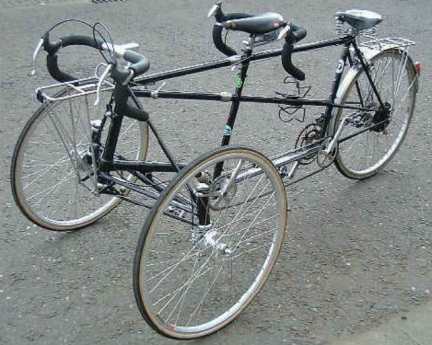
We ride wednesday! Come and cheer us on at BCIT willingdon Campus. Assembly starts at 10, racing by noon, fun for the whole family all day!

A Newton tandem tricycle conversion, but that's not all....
This was a job undertaken for one of our customers who wanted a little more stability. As the tandem already had S&S couplings it seemed logical to utilize them to fasten the tricycle conversion on. This was certainly one of the more 'interesting' jobs we have tackled.


The tricycle front end is held on with S&S couplings. This allows the normal front end to be replaced should the customer require it.
3 nuts, 3 cable connectors and off it comes.

Most tandems are set up so that the stoker's and pilot's cranks and pedals are syncronized. When the pilot's left crank is at the top of its rotation, the stoker's left crank is also straight up. This condition is called having the cranks "in phase."Some tandemists prefer a different setup, in which the cranks are "out of phase." The most common alternate setup is for the pilot's cranks to be horizontal while the stoker's cranks are vertical. This is called "90 degrees out of phase" because the cranks are at a 90 degree angle to one another. If the captain's cranks are 90 degrees forward of the stoker's cranks, we say the captain's cranks are leading by 90 derees.
In phase Out of phase Both riders move together, for more of a "team" feel.
Slow-speed handling is better.Less risk of striking a pedal on the road while turning, because both inside cranks can be in the up position at the same time.
Power is applied to the wheels in pulses. When both cranks are vertical, little power can be applied, which can cause the tandem to stall in a steep climb.
Standing to pedal is easier when both riders move together.
Riders move differently from one another, as each is in a different part of the power stroke. The pilot must remember where his stoker's pedals are in a turn.
Power is applied in a smooth flow, because while one set of cranks is at dead center, the other is in the heart of its power stroke.
This can help in steep climbs, and also reduces stress to some drive-train parts, since both riders are never applying full power at the same time.
"There are essentially three entities riding a tandem:
The captain, the stoker, and the spirit.
It is the spirit who likes in-phase cranks."--Osman Isvan
Any tandem team needs to come to terms with the cadence issue. With practice and patience, most couples can work this out on a standard tandem. Some teams, particularly those who are not well-matched in leg length or pedaling style may need to go to a technical fix.
The simplest way to accommodate disparate cadence preferences is to install different length cranks for the stoker and for the pilot.In general, for any given rider, the shorter the cranks are, the easier it becomes to spin a rapid cadence. If the rider who prefers a faster cadence gets longer cranks, this will develop a preference for a slightly slower cadence. If the rider who prefers a slower cadence gets shorter cranks, it will become easier to pedal at a faster rate. The most common crank length is 170 mm. This is what comes stock on most tandems. If you find that you have serious cadence incompatibility, start by installing 175 mm cranks for the rider who wants a faster cadence. If this helps, but not enough, get 165 mm cranks for the rider who has trouble pedaling fast.
Note, changing the crank length doesn't directly change the cadence, and both riders will still be pedaling at the same cadence, but the longer cranks will encourage the "spinner" to slow down a bit, and the shorter cranks will make it easier for the "slogger" to keep up.
Both of these options are possible, and available, but not on standard tandems. With tandems of conventional geometry, the cranks must move at the same speed, because if not, the time will come when one the pilot's left crank is pointing backward, while the stoker's left crank is facing forward, and their feet will collide!
To make independent gearing/independent coasting work, you either need a tandem with a longer than usual spacing between the riders, or a recumbent.
Independent gearing/independent coasting does add to the complexity and weight of a tandem, but for some riders it is worth the cost.


Personal Log
| In Class Activity | |
| Out of Class Activity | |
| Insights/Learning | |
| Group Dynamics | |